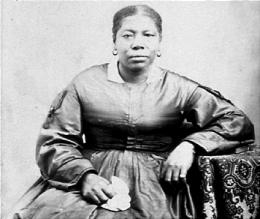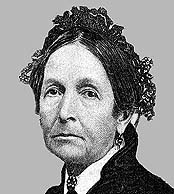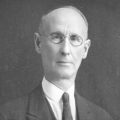Jane Elizabeth Manning is perhaps the most famous black Mormon pioneer. Mormon is a nickname for members of The Church of Jesus Christ of Latter-day Saints. She was the daughter of Isaac and Elizabeth Manning and was born in the late 1810s or early 1820s. She was never a slave but was a servant, sent to live and work in the home of a wealthy white farmer when she was only six years old. The home belonged to an elderly man, Joseph Fitch and his wife. Their daughter raised Jane.
Jane became a Presbyterian when she was fourteen years old, but felt unsatisfied with all they taught. She converted to Mormonism a year and a half later after hearing Charles Wendell teach about Mormonism. She had attended the sermon in direct defiance of her pastor’s order to her to not attend. She helped to convert other members of her family. At that time in Mormon history, Mormons were encouraged to gather in one place due to the need for protection during persecution and also due to difficulties in communication at the time. With a newly growing faith, it was easier to have everyone together where they could be taught by their leaders and enjoy the support of others who shared their faith.
Just a year after her baptism Jane and eight other members of her family accordingly set out for Nauvoo, Illinois, where the Mormons were then living. The group included her mother, her siblings, her brother-in-law and her sister-in-law. Despite still being just a teenager, Jane functioned as the leader of the group.
They started their journey with a group of both white and black Mormons, but when the integrated group reached the ferry, the black Mormons were denied passage. Some reports say they were denied passage due to race. Jane’s biography, dictated to someone, states the ferry tried to force them to pay sooner than expected and they did not have the money yet to pay. It’s possible the early payment was due to race, since the white Mormons in the group seemed to have been able to continue. The group decided the white Mormons should continue their journey while the black Mormons would finish their journey on foot, having no other way to get there. A smaller group is easier to support when your supplies were not meant to sustain a long journey.
The remaining distance was 800 miles and it was a cold October, but they walked it under Jane’s competent leadership. Their feet bled so badly Jane recorded that you could follow their path through the bloody but complete footprints. They stopped and prayed their feet would be healed so they could continue. Their prayers were answered and they made it to Illinois.
However, when they reached Peoria, they were once again stopped. The black Mormons were presumed to be runaway slaves and when they couldn’t produce freedom papers—because they had never been slaves to begin with—they were threatened with prison. Eventually they were allowed to go free, but they remained afraid of a repeat of this problem. The remaining journey were perilous. They had to cross a river with cold water up to their necks and they had little food. They often had to sleep outside in the snow. A baby became ill and they prayed it back to health even though the church leaders had given up on it. Their feet were injured and they prayed them back into well-being. They sang hymns and focused on the eternal perspective, giving them the courage and strength to continue their journey.
When they finally arrived in Nauvoo, they first encountered Orson Spencer, who directed them to Joseph Smith’s own home. Joseph’s wife, Emma, saw them coming from the doorway where she stood and brought them into the house and Joseph added chairs to the table for them. Since Jane was the leader of this small group of black Mormons, he asked her to tell her story. He then invited them to stay as guests in his home until they found jobs and homes of their own and assured them they were among friends now and they’d be protected from the racism and persecution they had experienced in their journey.
Everyone but Jane quickly found work and homes. When only Jane remained, Joseph found Jane crying because she had no home or job. He told her she always had a home with him and Emma. Emma asked her what type of work she could do and Jane outlined a variety of housekeeping skills. She offered to start that moment, but Emma told her to rest—she had been very frightened and sad—and to start the next day, doing laundry if that was what she liked to do. He and Emma offered her a job working for them. She continued to live with them for several months. She developed a close friendship with Joseph’s mother and with other women who lived in the home.
Jane was proud that when Joseph Smith ran for president of the United States, one part of his platform was one to free the slaves, because, he said, “‘an hour of virtuous liberty on earth is worth a whole eternity of bondage.”
When Joseph was martyred, her brother Isaac, who worked for Joseph Smith as a clerk, was one of the men who helped to dig the grave for the prophet and to safely escort his body there.
After Joseph’s murder, she moved into the home of Brigham Young, the new prophet, and worked for him. While there she married Isaac James, a free black Mormon.
The Mormons were forced to flee Nauvoo in the face of horrendous persecution, and while stopped at Winter Quarters en route to the Salt Lake Valley, Jane became the mother of Silas. The housing was poor for the harsh winter weather, but Jane had become accustomed to hardship. The Mormons headed toward Utah in groups. Brigham Young and a small group went first to select a precise location. It is believed Jane and her husband were in the lead group of the groups that followed later. Her brother remained in Missouri until eighteen years before his death, where he was treated with great deference and respect by church leaders for his great service to the church and to Joseph Smith. The prophet, Joseph F. Smith, would speak at his funeral, along with one of the apostles.
Conditions were harsh for the Mormons in Salt Lake at first. There was often not enough food and Jane insisted on sharing half of what little she did have with her friend Eliza Partridge Lyman, who had nothing at all while her husband was away on a mission.
Jane and her husband worked hard—Isaac worked for Brigham Young–and earned the means to obtain a home and animals, but the infamous cricket invasion wiped out much of their hard work. They rebuilt and eventually became one of the wealthier families in their “ward.” Together they had seven children.
Sadly, Jane’s husband left the family and Jane found herself a single parent with a large family. She was highly self-sufficient, and although they struggled financially, they managed. She gardened, made her own soap, and did her own spinning and sewing. She brought in a small amount of cash by taking in laundry. For twenty years she cared for her family alone. Then her husband returned and re-established a relationship with his family and again became a practicing Mormon. Jane would outlive him and all but two of her children.
Jane was noted for her untiring service to the church and community, despite the challenges of being a single parent. Her level of service, and her insistence on donating funds to build temples and help with Native American programs was so great that in later years, church leaders reserved seats in the center front of the tabernacle for her and her brother when important meetings were held.
Jane took pride in being a black Mormon. Both parts of her identity mattered to her and she said near the end of her life that her testimony was as strong then as it had been the day she joined the church.
Jane Manning James died in 1908. Several top Mormon leaders, including Joseph F. Smith, spoke at her funeral. Joseph F. Smith was the prophet of the Mormon Church at that time.
About Terrie Lynn Bittner
The late Terrie Lynn Bittner—beloved wife, mother, grandmother, and friend—was the author of two homeschooling books and numerous articles, including several that appeared in Latter-day Saint magazines. She became a member of the Church at the age of 17 and began sharing her faith online in 1992.







Thanks for this short biography of Jane Manning. I love her story, but have never read it for myself. It’s inspiring of courage and perseverance in our own lives.
What a great History. Thank you for sharing!